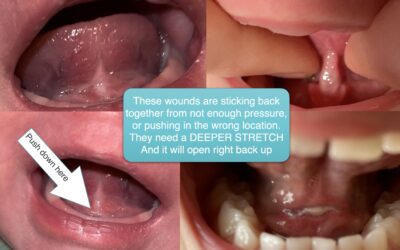Follow up is critical in dentistry and medicine. When treating a patient who is tongue-tied, it’s important to ensure it did not grow back together, important to ensure the patient saw improvements, and if not, determine what other team members the patient needs to see if they haven’t already.
This mother’s story shows why it’s important to get patients back for follow-up.
We get patients back for follow-up for three main reasons:
- To see what happened.
- To help the patient if any issues still exist.
- Continuous improvement, so we can do better for each patient.
Also, if you don’t get the patient back for follow-up, you will never know if the procedure worked or not. By getting every patient back (well, unless they live farther than 4hrs away), and doing a virtual follow-up for those farther away, we can make connections between treatment and symptom improvement.
Our symptom assessment sheets that we came up with that have 50 common speech, feeding, sleep, and “other” symptoms related to tongue-tie came about because we were diligent about getting patients back for follow up. Then we could see patterns of what improved and what didn’t.
I was at a meeting recently and was discussing with an ENT in our town who clips tongue-ties, and he said, “Why would I need to get them back for follow up?” This mentality is pervasive, and since a follow-up doesn’t pay anything, it seems worthless. But the follow up is the best part! The patients very often are so excited to tell you about how much better their child is doing, and are so thankful they did the procedure… if you did it properly, and the child was diagnosed correctly.
If you don’t do a full release, you will see your work more clearly at the one-week follow-up, and improve for next time. Sometimes, issues the child was struggling with were also related to torticollis (a tight SCM) and they need to see a Chiropractor or PT. Sometimes they saw no improvements, and they need encouragement… occasionally, especially for older babies or children, it takes 2 or even 3 weeks for them to see the positive changes.
Often at the follow up (maybe 95%) the parents were not able to stretch the tissue as well, or had a hard time getting in their child’s mouth, so the tongue or lip-tie grew back together a little bit (reattachment / readhesion). When you show them the stretch again, often that scab will pop back open, and allow full mobility once again, and any symptoms that improved – then got worse – will often improve again.
Some parents say the pain from nursing was better for a few days, then got worse again. If that’s the case, it was likely growing back together. Just a little reattachment can make improvements disappear. So aftercare stretches as well as a follow-up to check on the sites and counsel the parents are critical to tongue-tie treatment. We want to give each patient the best chance of seeing as many improvements as possible, and follow-up is one key to making that happen.
If your child was incompletely released, still has issues after a tongue-tie release, and/or no follow-up visit or stretches were recommended, we’d be happy to talk with you. Call us at 205-419-4333 or send us a message.
To learn more about performing tongue-tie releases, check out our Professionals page, where you can download our Follow-Up forms, Assessment forms, as well as a free digital copy of Tongue-Tied which explains all of this in detail.
Written permission from mom to share the testimonial obtained.



